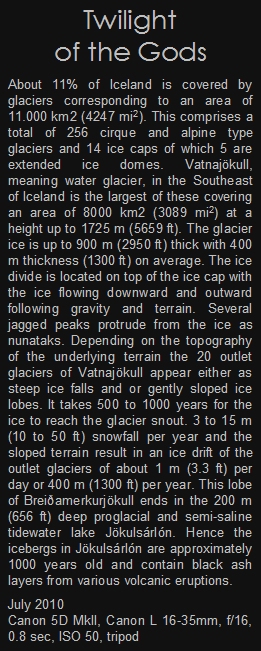

Twilight of the Gods
About 11% of Iceland is covered by glaciers corresponding to an area of 11.000 km2 (4247 mi2). This comprises a total of 256 cirque and alpine type glaciers and 14 ice caps of which 5 are extended ice domes. Vatnajökull, meaning water glacier, in the Southeast of Iceland is the largest of these covering an area of 8000 km2 (3089 mi2) at a height up to 1725 m (5659 ft). The glacier ice is up to 900 m (2950 ft) thick with 400 m thickness (1300 ft) on average. The ice divide is located on top of the ice cap with the ice flowing downward and outward following gravity and terrain. Several jagged peaks protrude from the ice as nunataks. Depending on the topography of the underlying terrain the 20 outlet glaciers of Vatnajökull appear either as steep ice falls and or gently sloped ice lobes. It takes 500 to 1000 years for the ice to reach the glacier snout. 3 to 15 m (10 to 50 ft) snowfall per year and the sloped terrain result in an ice drift of the outlet glaciers of about 1 m (3.3 ft) per day or 400 m (1300 ft) per year. This lobe of Breišamerkurjökull ends in the 200 m (656 ft) deep proglacial and semi-saline tidewater lake Jökulsįrlón. Hence the icebergs in Jökulsįrlón are approximately 1000 years old and contain black ash layers from various volcanic eruptions.
July 2010
Canon 5D MkII, Canon L 16-35 mm, f/16, 0.8 sec, ISO 50, tripod




















